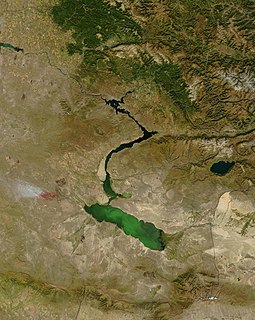 W
WAn ancient lake is a lake that has consistently carried water for more than one million years. Many have existed for more than 2.6 million years, the full Quaternary period. Ancient lakes continue to persist due to plate tectonics in an active rift zone. This active rift zone creates lakes that are extremely deep and difficult to naturally fill with sediment. Due to the prolonged life of ancient lakes, they serve as models for isolated evolutionary traits and speciation. Most of the world's bodies of water are less than 18,000 years old. There are only 20 ancient lakes over 1 million years old.
 W
WThe Aral Sea was an endorheic lake lying between Kazakhstan and Uzbekistan which began shrinking in the 1960s and had largely dried up by the 2010s. The name roughly translates as "Sea of Islands", referring to over 1,100 islands that had dotted its waters. In the Mongolic and Turkic languages aral means "island, archipelago". The Aral Sea drainage basin encompasses Uzbekistan and parts of Tajikistan, Turkmenistan, Kyrgyzstan, Kazakhstan, Afghanistan, and Iran.
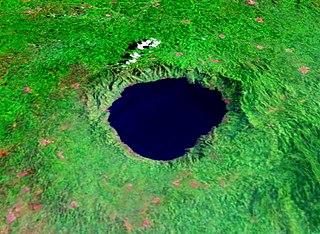 W
WLake Bosumtwi is the only natural lake in Ghana. It is situated within an ancient impact crater that is about 10.5 kilometres (6.5 mi) in diameter. It is about 30 km (19 mi) south-east of Kumasi the capital of Ashanti and is a popular recreational area. There are about 30 villages near crater lake Lake Bosumtwi, with a combined population of about 70,000 Ashanti people. The most popular amongst the villages where tourists usually settle is Abono.
 W
WThe Caspian Sea is the world's largest inland body of water, variously classed as the world's largest lake or a full-fledged sea. As an endorheic basin, it lies between Europe and Asia; east of the Caucasus, west of the broad steppe of Central Asia, south of the fertile plains of Southern Russia in Eastern Europe, and north of the mountainous Iranian Plateau of Western Asia. It covers 371,000 km2 (143,000 sq mi) and a volume of 78,200 km3 (19,000 cu mi). It has a salinity of approximately 1.2%, about a third that of average seawater. It is bounded by Kazakhstan from mid-north to mid-east, Russia from mid-north to mid-west, Azerbaijan to the southwest, Iran to the south and adjacent corners, and Turkmenistan along southern parts of its eastern coast.
 W
WIssyk-Kul is an endorheic lake in the Northern Tian Shan mountains in Eastern Kyrgyzstan. It is the seventh deepest lake in the world, the tenth largest lake in the world by volume and the second largest saline lake after the Caspian Sea. Issyk-Kul means "warm lake" in the Kyrgyz language; although it is surrounded by snow-capped peaks, it never freezes.
 W
WLake Khövsgöl is the largest fresh water lake in Mongolia by volume and second largest by area. It is located near the northern border of Mongolia, about 200 km west of the southern end of Lake Baikal. It is nicknamed the "Younger sister" of those two "sister lakes".
 W
WLake Baikal is a rift lake located in southern Siberia, Russia, between Irkutsk Oblast to the northwest and the Buryat Republic to the southeast.
 W
WLake Biwa is the largest freshwater lake in Japan, located entirely within Shiga Prefecture, northeast of the former capital city of Kyoto. Lake Biwa is an ancient lake, over 4 million years old. It is estimated to be the 13th oldest lake in the world. Because of its proximity to the ancient capital, references to Lake Biwa appear frequently in Japanese literature, particularly in poetry and in historical accounts of battles.
 W
WLake Eyre, officially known as Kati Thanda–Lake Eyre, is an endorheic lake in east-central Far North South Australia, some 700 km (435 mi) north of Adelaide. The shallow lake is the depocentre of the vast endorheic Lake Eyre basin, and contains the lowest natural point in Australia at approximately 15 m (49 ft) below sea level (AHD), and on the rare occasions that it fills completely, is the largest lake in Australia covering an area up to 9,500 km2 (3,668 sq mi). When the lake is full, it has the same salinity level as seawater, but becomes hypersaline as the lake dries up and the water evaporates.
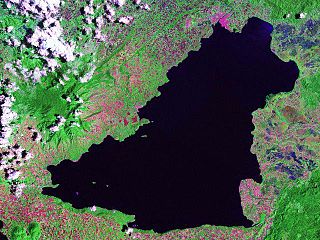 W
WLake Lanao is a large ancient lake in the Philippines, located in Lanao del Sur province in the country's southern island of Mindanao. With a surface area of 340 km2 (130 sq mi), it is the largest lake in Mindanao, and the second largest lake in the Philippines and counted as one of the 15 ancient lakes in the world. Scholars have been pushing for the lake's inclusion in the UNESCO World Heritage List.
 W
WLake Maracaibo is a large brackish tidal bay in Venezuela and an "inlet of the Caribbean Sea". It is sometimes considered a lake rather than a bay or lagoon. It is connected to the Gulf of Venezuela by Tablazo Strait, which is 5.5 kilometres (3.4 mi) wide at the northern end. It is fed by numerous rivers, the largest being the Catatumbo. At 13,210 square kilometres (5,100 sq mi) it was once the largest lake in South America; the geological record shows that it was a true lake in the past, and as such is one of the oldest lakes on Earth at 20–36 million years old.
 W
WLake Ohrid is a lake which straddles the mountainous border between the southwestern part of North Macedonia and eastern Albania. It is one of Europe's deepest and oldest lakes, with a unique aquatic ecosystem of worldwide importance, with more than 200 endemic species.
 W
WThe Prespa lakes are two freshwater lakes, with the larger shared between North Macedonia, Albania, and Greece, and the smaller shared between Greece and Albania. Of the total surface area of the larger lake, 176.3 km2 (68.07 sq mi) belongs to North Macedonia, 46.3 km2 (17.88 sq mi) to Albania and 36.4 km2 (14.05 sq mi) to Greece. They are the highest tectonic lakes in the Balkans, standing at an elevation of 853 m (2,798 ft).
 W
WLake Tahoe is a large freshwater lake in the Sierra Nevada of the United States. Lying at 6,225 ft (1,897 m), it straddles the state line between California and Nevada, west of Carson City. Lake Tahoe is the largest alpine lake in North America, and at 122,160,280 acre⋅ft (150.7 km3) trails only the five Great Lakes as the largest by volume in the United States. Its depth is 1,645 ft (501 m), making it the second deepest in the United States after Crater Lake in Oregon.
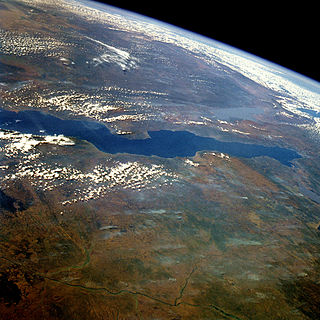 W
WLake Tanganyika is an African Great Lake. It is the second-oldest freshwater lake in the world, the second-largest by volume, and the second-deepest, in all cases after Lake Baikal in Siberia. It is the world's longest freshwater lake. The lake is shared between four countries – Tanzania, the Democratic Republic of the Congo (DRC), Burundi, and Zambia, with Tanzania (46%) and DRC (40%) possessing the majority of the lake. It drains into the Congo River system and ultimately into the Atlantic Ocean.
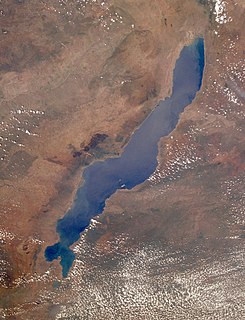 W
WLake Malawi, also known as Lake Nyasa in Tanzania and Lago Niassa in Mozambique, is an African Great Lake and the southernmost lake in the East African Rift system, located between Malawi, Mozambique and Tanzania.
 W
WThe Pingualuit Crater, formerly called the "Chubb Crater" and later the "New Quebec Crater", is a relatively young impact crater located on the Ungava Peninsula in the administrative region of Nord-du-Québec, in Quebec, Canada. It is 3.44 km (2.14 mi) in diameter, and is estimated to be 1.4 ± 0.1 million years old (Pleistocene). The crater and the surrounding area are now part of Pingualuit National Park. The only species of fish in the crater lake is the Arctic char.
 W
WLake Titicaca is a large, deep, freshwater lake in the Andes on the border of Bolivia and Peru, often called the "highest navigable lake" in the world. By volume of water and by surface area, it is the largest lake in South America.
 W
WTule Lake is an intermittent lake covering an area of 13,000 acres (53 km2), 8.0 km (5.0 mi) long and 4.8 km (3.0 mi) across, in northeastern Siskiyou County and northwestern Modoc County in California, along the border with Oregon.
 W
WLake Vostok is the largest of Antarctica's almost 400 known subglacial lakes. Lake Vostok is located at the southern Pole of Cold, beneath Russia's Vostok Station under the surface of the central East Antarctic Ice Sheet, which is at 3,488 m (11,444 ft) above mean sea level. The surface of this fresh water lake is approximately 4,000 m (13,100 ft) under the surface of the ice, which places it at approximately 500 m (1,600 ft) below sea level.
 W
WLake Zaysan is a freshwater lake, ca. 1,810 km² (700 mi²), in eastern Kazakhstan, in a hollow between the Altai and the Tarbagatai Mountains. It is the largest lake in the East Kazakhstan Region.